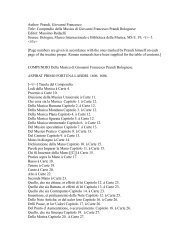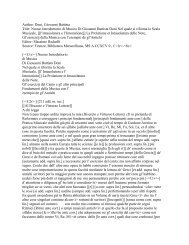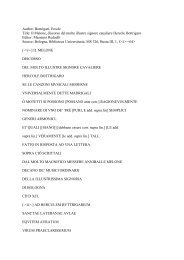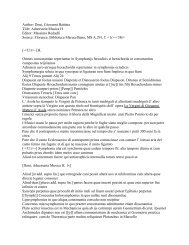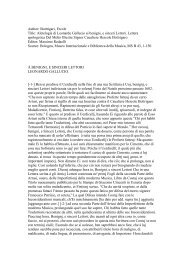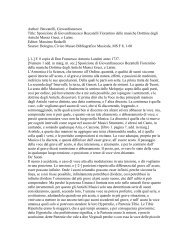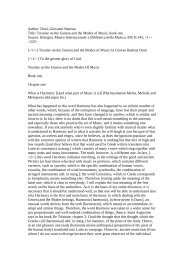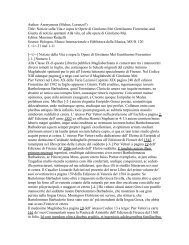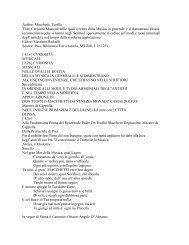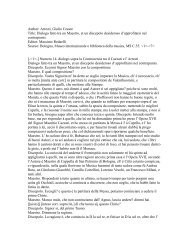Author: Dentice, Luigi - manuscripts of italian music theory in ...
Author: Dentice, Luigi - manuscripts of italian music theory in ...
Author: Dentice, Luigi - manuscripts of italian music theory in ...
You also want an ePaper? Increase the reach of your titles
YUMPU automatically turns print PDFs into web optimized ePapers that Google loves.
the diapason consonance represented by the dupla. The hammer weigh<strong>in</strong>g 12 and the one<br />
weigh<strong>in</strong>g 9, as well as the ones weigh<strong>in</strong>g 8 and 6 form an Epitrite proportion and sound<br />
the diatessaron. The ones weigh<strong>in</strong>g 9 and 6 and 12 and 8 produced the consonance<br />
diapente, while the two weigh<strong>in</strong>g 9 and 8 sounded the tone.<br />
Serone. Now I understand well.<br />
Soardo. Pythagoras, after he returned home from the blacksmiths’ workshop, then<br />
exam<strong>in</strong>ed with<strong>in</strong> himself many times if the entire reason<strong>in</strong>g beh<strong>in</strong>d the consonances<br />
consisted <strong>in</strong> these proportions. Thus, he arranged the correct weights to some str<strong>in</strong>gs and<br />
judged with his ear the consonances that they produced, while on other occasions he<br />
found out what the truth was from the pipes, by halv<strong>in</strong>g them, doubl<strong>in</strong>g them <strong>in</strong> size and<br />
measur<strong>in</strong>g them accord<strong>in</strong>g to all the other proportions. Very <strong>of</strong>ten he placed certa<strong>in</strong> vases<br />
(that Pl<strong>in</strong>y describes as weigh<strong>in</strong>g ten drachmas) as a means <strong>of</strong> measurement <strong>in</strong>to the<br />
vases, namely [-f.9r-] <strong>in</strong>to certa<strong>in</strong> vases called hem<strong>in</strong>a by the Romans, and aga<strong>in</strong> he hit<br />
those vases <strong>of</strong> different weight with a beater <strong>of</strong> brass or iron, but he did not discover<br />
anyth<strong>in</strong>g different from what he thought. Therefore, he was pleased with the confirmation<br />
<strong>of</strong> his <strong>theory</strong> and he started to exam<strong>in</strong>e the length and thickness <strong>of</strong> the str<strong>in</strong>gs, and <strong>in</strong> this<br />
way he discovered a rule which took its name from its effect. A rule is not just a l<strong>in</strong>e<br />
aga<strong>in</strong>st which the length <strong>of</strong> the str<strong>in</strong>g and the sound are measured, but that it is statement<br />
so true and fixed that it may not fail to achieve all that it looks for when scrut<strong>in</strong>ised by an<br />
unconv<strong>in</strong>ced judge.<br />
Serone. You said a little earlier that the consonance is the reduction to agreement <strong>of</strong><br />
different voices together, s<strong>in</strong>ce one f<strong>in</strong>ds <strong>in</strong> arithmetic that all quantities that are unequal<br />
between each other can differ from each other accord<strong>in</strong>g to five types <strong>of</strong> <strong>in</strong>equality, so<br />
that either one quantity exceeds another by multiplicity <strong>in</strong> one or <strong>in</strong> more parts, or <strong>in</strong><br />
multiplicity and one part, or <strong>in</strong> multiplicity and several parts. Therefore, the first species<br />
<strong>of</strong> <strong>in</strong>equality is called multiplicity and it is the one where the larger number conta<strong>in</strong>s the<br />
smaller number two, three or four time, and there is noth<strong>in</strong>g left or lack<strong>in</strong>g. This is called<br />
dupla, tripla or quadrupla, so that one can cont<strong>in</strong>ue follow<strong>in</strong>g said sequence ad <strong>in</strong>f<strong>in</strong>itum.<br />
The second species <strong>of</strong> <strong>in</strong>equality is called superparticular, and it occurs when the larger<br />
number conta<strong>in</strong>s with<strong>in</strong> itself the whole <strong>of</strong> the smaller one and a part <strong>of</strong> it, either half <strong>of</strong><br />
those parts, as <strong>in</strong> the proportion from three to two, which is called sesquialtera, or the<br />
third part, which is called sesquitertia. The third species <strong>of</strong> <strong>in</strong>equality occurs when the<br />
larger number conta<strong>in</strong>s the whole <strong>of</strong> the smaller one and some parts <strong>of</strong> it. If the larger<br />
exceeds the smaller by two parts, it will be called <strong>of</strong> soprabipartiente proportion, as <strong>in</strong> the<br />
case <strong>of</strong> five and three, while, if it exceeds it by the parts, it will be called sopratripartiente,<br />
as <strong>in</strong> the case <strong>of</strong> seven and four, and all the others are similar to these. The fourth species<br />
<strong>of</strong> <strong>in</strong>equality is the one produced by the union <strong>of</strong> the multiplex and the superparticular. It<br />
takes place when the larger number conta<strong>in</strong>s the smaller two, three or as many parts as<br />
you like, and some portion <strong>of</strong> it. If the larger number conta<strong>in</strong>s the smaller twice and half<br />
<strong>of</strong> the smaller, it will be called double sesquialter, as <strong>in</strong> the case <strong>of</strong> five and two. If it<br />
conta<strong>in</strong>s twice the smaller and a third <strong>of</strong> it, it will be called [-f.9v-] double sesquitertio, as<br />
<strong>in</strong> the case <strong>of</strong> seven and three. If it conta<strong>in</strong>s the smaller three times and a half, it will be<br />
called Triple sesquialtero, as <strong>in</strong> the case <strong>of</strong> seven and two. Their names are varied <strong>in</strong> this<br />
way accord<strong>in</strong>g to multiplicity and superparticularity. The fifth and f<strong>in</strong>al species <strong>of</strong><br />
<strong>in</strong>equality is called multiplex superpartiente, and it takes place when the larger number<br />
conta<strong>in</strong>s the entire smaller one more than once, and more than a part <strong>of</strong> the smaller one. If<br />
the larger number embraces the smaller one twice, and two parts <strong>of</strong> it, it will be called<br />
dupla soprabipartiente, as <strong>in</strong> the case <strong>of</strong> eight and three. If it conta<strong>in</strong>s it three times and<br />
two parts <strong>of</strong> it, it will be called tripla soprabipartiente as <strong>in</strong> the case <strong>of</strong> eleven and three.<br />
However, I would like to know which <strong>of</strong> these species are appropriate to the <strong>music</strong>al



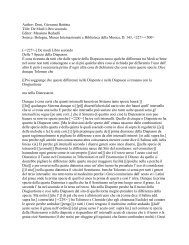
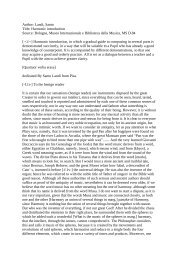
![Doni, Giovanni Battista Title: Trattato Dei Tuoni o [[Harmonie de]]](https://img.yumpu.com/45461005/1/190x245/doni-giovanni-battista-title-trattato-dei-tuoni-o-harmonie-de.jpg?quality=85)
